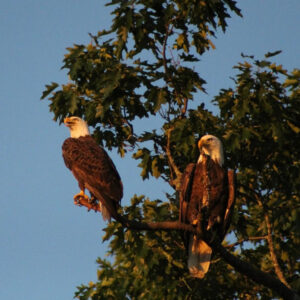Big Birds
By Brian Harrington
 We all see them soaring, but do we know what they are? Eagles, vultures, ospreys and large hawks––they all ply and fly the skies of our Herring River Watershed, and they all look pretty similar at a quick glance. But, with attention to detail (size, shape and behavior), they are readily told from one another.
We all see them soaring, but do we know what they are? Eagles, vultures, ospreys and large hawks––they all ply and fly the skies of our Herring River Watershed, and they all look pretty similar at a quick glance. But, with attention to detail (size, shape and behavior), they are readily told from one another.
The biggest are the Bald Eagles and Turkey Vultures (wing spans just under 7 feet); next are the ospreys (span about 6 feet) and finally the largest buteo hawks (span about 4 feet).
Eagles from Vultures. Oh, so easy.….the eagles have a big, white head! Well, sometimes, but many of them do not. A youngster can be almost all dark brown, similar to the dark colors of vultures. As eagles develop towards adulthood (4–5 years) they grow white feathers in underwings and under tails. Many of the local eagles I see are sub-adults, readily confused for a vulture. A key difference is in how they hold wings, horizontally (“flat as a board”) in soaring eagles, and in a dihedral or V-shaped angle in vultures. Flying vultures tend to “flop, rock, waver and veer” while eagles seem more “solid, unwavering, and direct” in flight. Also, look for the red color on the head of Turkey Vultures.

American Bald Eagle, juvenile
Osprey from Eagles. Ospreys are often confused for eagles (white heads, similar shape) but are separable on seeing their largely white breast and belly. Ospreys also have an arced wing-shape, with the bend of the wing typically higher and more forward than the wing tips. When fishing, Ospreys often hover, or fly in tight circles over water, behaviors that are absent or unusual in eagles, vultures or large hawks. They also often call while in flight, a high-pitched, wheezy flight call https://www.bird-sounds.net/osprey/ .
Large Hawks. Our most common and largest hawks are Red-tailed Hawks, which are in the category of a Buteo hawk, and are notably smaller than the species listed above. Buteos, with short and broad wings, are shaped for soaring, usually in circular patterns at mid- and high altitudes. They like open space. They appear to have very short necks compared to the eagles, vultures and ospreys. Like ospreys, they sometimes call while circling overhead https://www.bird-sounds.net/red-tailed-hawk/ .

Red-tailed Hawk, hovering
Our next most common, and slightly smaller buteo is the Red-shouldered Hawk with its characteristically black-and-white-banded tail. Once almost extirpated by DDT, they are increasingly seen in our watershed.
Want to learn more about bird identification? Get A Free Birding ID App — Download The Merlin App and start ID-ing birds yourself. Merlin Bird App

Comments
Big Birds — No Comments
HTML tags allowed in your comment: <a href="" title=""> <abbr title=""> <acronym title=""> <b> <blockquote cite=""> <cite> <code> <del datetime=""> <em> <i> <q cite=""> <s> <strike> <strong>